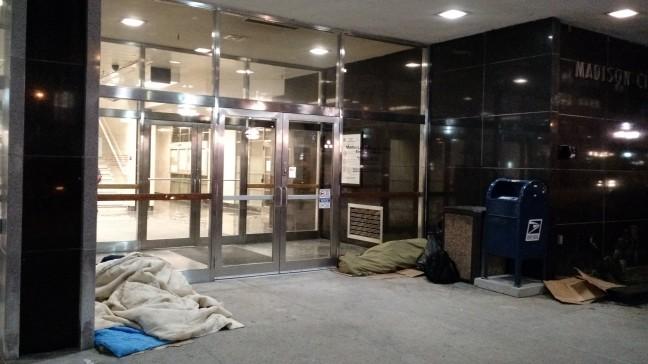In order to provide homeless women driven away from the City County Building with a place to sleep, the Salvation Army of Dane County women’s shelter is increasing the number of days per year each woman may stay in the facility.
The women’s shelter is increasing the number of days that single women over the age of 18 may stay in the facility from 60 to 90 days per year as a trial run. The shelter has worked closely with Porchlight, which runs the men’s shelter, and the YWCA to try to provide more opportunities for people to find somewhere to sleep legally, Karen Potneck, services coordinator for the Salvation Army of Dane County women’s shelter, said.
This increase in available days is in direct response to the homeless being banned from the steps of the City County Building, Potneck said.
Local leaders gather to speak against banning homeless from city buildings
All women who have already used up their 60 days for the year may go back to stay another 30 days at the shelter, according to a statement by the Salvation Army of Dane County.
The specific increase in days was chosen because that is the number of days available to families at the family shelter every year, she said.
“Our families can stay for 90 days, and we wanted to be as fair as possible,” Potneck said.
There is typically more funding for programs aimed at assisting families, whereas programs for single individuals are typically less supported, Potneck said.
The increase to 90 days is also designed to provide more time for homeless individuals to find a place to stay once their time at the shelter has run out, she said.
“In Madison, it is almost impossible to find affordable housing, especially in 60 days,” Potneck said. “This will give women more time to find housing.”
Though this increases the number of days per year that a woman may stay in the shelter, it does not change the number of women that can stay in the shelter every night — that number remains capped at 30, she said. The fact that the same number of women will be helped every night will help the shelter from becoming overwhelmed by demand.
With winter approaching, the shelters are nearing the time of “cold weather nights,” which occur when the temperature drops below 20 degrees. In this case, all women are welcomed into the shelter, according to the statement.
“This puts a strain on our budget with feeding and staffing,” Potneck said. “But somehow, someway, we still make it work.”
Procuring enough funding to provide suitable living quarters and meals is an ongoing challenge for many shelters, and the women’s shelter is no exception.
Though winter does pose a hardship for many homeless individuals, Potneck said she worries about women even when temperatures are not subzero.
“I worry the most about the women who run out of their days when it is 30 degrees out,” Potneck said. “That’s still cold.”












